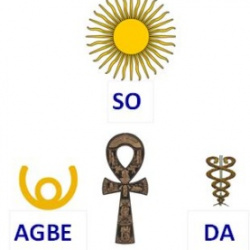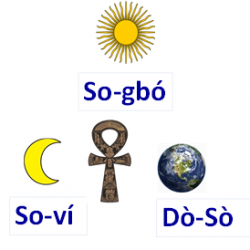YEƲE, Jah, Ama/Amɔ, Hũ, Ahi, Trɔn, Aba, Aza, Ana, etc.: diluted copies done by Non-Africans from these African metaphysical Concepts and Notions can never replace the genuine African Original!
Many people often believe wrongly that the word YEƲE as well as many other words and their metaphysical meaning among the West African People living in the Gulf of Guinea might have beeing borrowed from the jewish or hebraic traditions through the violent and brutal christianization since the 18th century C.E. (common era).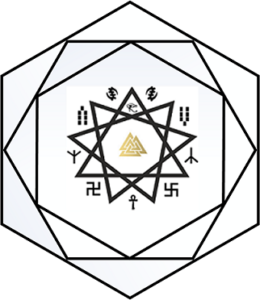 Some other people even believe not only wrongly, but also by ignorance coupled with a stinking arrogance, that African People did not have any clean idea of God before the violent islamization and christianization. They also allegate fallaciously very often that African Societies and Cultures before this violent islamization and christianization did not have any clean Teaching and Practice that enable people to communicate constantly with the Almighty.
But all these ideological lies cannot hide the undeniable historical Fact testifying that the ancestors of the Hebrews known as Hyksos were not worshiping any tribal God or tribal Deity called Yavhe (or Yahwe) when they were arriving as begging immigrants in Egypt around 1550 B.C.E (before common era!) during the reign of the Faraos Nehesi and Meredjefare. As semitic immigrants the ancestors of the Hebrews were worshiping a typical semitic deity known as Ba’al (or Baal), as it is attested by many serious historical and theological Studies (Kinet 1977, Kohlmeyer 1982, Niehr 1998, Niehr 2003).
The word YEƲE as well as all the other metaphysical words mentionned above and many others in the field of the hebraic Kabbala and in the jewish religious practices came from the mystical and religious circles of the multi-ethnic pharaonic Egypt and have been adopted through linguistic borrowing by all these immigrants that came into contact with the multi-ethnic and multi-lingual egyptian society.
This word always in use in the Egyptian mystical and spiritual circles long time before the massive immigration of many neighbouring aliens refer to the cosmogonical and spiritual Complexity of the Divine Creation that is structured permanently, not as a simple Trinity as the Judeo-Christian Plagiarism claim it wrongly and fallaciously, but rather in the form of a Triple Trinity.
Some other people even believe not only wrongly, but also by ignorance coupled with a stinking arrogance, that African People did not have any clean idea of God before the violent islamization and christianization. They also allegate fallaciously very often that African Societies and Cultures before this violent islamization and christianization did not have any clean Teaching and Practice that enable people to communicate constantly with the Almighty.
But all these ideological lies cannot hide the undeniable historical Fact testifying that the ancestors of the Hebrews known as Hyksos were not worshiping any tribal God or tribal Deity called Yavhe (or Yahwe) when they were arriving as begging immigrants in Egypt around 1550 B.C.E (before common era!) during the reign of the Faraos Nehesi and Meredjefare. As semitic immigrants the ancestors of the Hebrews were worshiping a typical semitic deity known as Ba’al (or Baal), as it is attested by many serious historical and theological Studies (Kinet 1977, Kohlmeyer 1982, Niehr 1998, Niehr 2003).
The word YEƲE as well as all the other metaphysical words mentionned above and many others in the field of the hebraic Kabbala and in the jewish religious practices came from the mystical and religious circles of the multi-ethnic pharaonic Egypt and have been adopted through linguistic borrowing by all these immigrants that came into contact with the multi-ethnic and multi-lingual egyptian society.
This word always in use in the Egyptian mystical and spiritual circles long time before the massive immigration of many neighbouring aliens refer to the cosmogonical and spiritual Complexity of the Divine Creation that is structured permanently, not as a simple Trinity as the Judeo-Christian Plagiarism claim it wrongly and fallaciously, but rather in the form of a Triple Trinity.
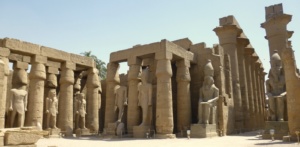 The word was used in these very close Egyptian circles such as the polyvalent Training Institutions known as House of Life (Per Ankh, see Photo), to refer to any concrete or covert energetic Principle that exists as part of an active Triad, that always acts in a triadic Interaction and that can be understood therefore as the concrete and permanent triadic Equilibrum in the whole Divine Creation, as the concrete Footprint of God the Almighty.
It was used loosely therefore to talk about any Deity, that is considered in the Egyptian worldview as part of a permanent and recurrent complex Triad.
The semitic immigrants started to adopt Egyptian habits and customs such as the circumcision and they also started borrowing many words from the different fields of activities in KMT (Egypt).
They started therefore to name their tribal Deity Ba’al with the same word YEƲE, like the Egyptians who used to name any important Triadic Deity in their Pantheon with this expression (cf. Kinet 1977 and Niehr 2003).
And the Hebrews have borrowed many other words from the Egyptian spiritual and mystical fields of activities, even though the phonetic pronounciation and the meaning of these borrowed words have been corrupted in the target language (the Hebrew), as it often happens in the case of any linguistic and cultural borrowing.
It is clear therefore why the hebraic/jewish mystical Tradition (known as the Kabbala) is full of many borrowed words from African Languages which are still in use in West African mystical and religious circles (e.g. the Gbè linguistic Cluster including Eʋègbè, Fɔngbe, Ajagbe, Wacigbe, Gɛngbe, Gungbe, χwlagbe, cf. Folikpo, 2006).
The Hebrew communities that have left later the Nile Delta to settle down in the Mountains of Sinaï during the reign of the Faraos Kamose and Ahmose I (around 1500 B.C.E.) did not only continue to call their tribal Deity with the corrupted epithet Yavhe that is derived from the word YEƲE, but they also kept the other expressions and notions they have wrongly borrowed from the Egyptian society.
The second group of Hebrew communities that had left Egpyt during the reign of the Farao Ramses II brought these religious practices in the region of Canaan and Midian (cf. Folikpo 2017).
It is obvious therefore that the semitic tribal Deity known as Ba’al has undergone a religious and cultural metamorphosis through the contact with Egypt where it has received a new epithet (Yavhe) and new practices for worshiping (cf. Folikpo 2017).
Since the Hebrews did not discover by their own or invent by their own the concept of Divine Triad and the expression YEƲE, but have copied them (wrongly) from the Egyptian Culture and Civilization, it is obvious why they could never give any clear cosmonogical explanation for them and have always covered them with a certain speculative “mystery”.
The word was used in these very close Egyptian circles such as the polyvalent Training Institutions known as House of Life (Per Ankh, see Photo), to refer to any concrete or covert energetic Principle that exists as part of an active Triad, that always acts in a triadic Interaction and that can be understood therefore as the concrete and permanent triadic Equilibrum in the whole Divine Creation, as the concrete Footprint of God the Almighty.
It was used loosely therefore to talk about any Deity, that is considered in the Egyptian worldview as part of a permanent and recurrent complex Triad.
The semitic immigrants started to adopt Egyptian habits and customs such as the circumcision and they also started borrowing many words from the different fields of activities in KMT (Egypt).
They started therefore to name their tribal Deity Ba’al with the same word YEƲE, like the Egyptians who used to name any important Triadic Deity in their Pantheon with this expression (cf. Kinet 1977 and Niehr 2003).
And the Hebrews have borrowed many other words from the Egyptian spiritual and mystical fields of activities, even though the phonetic pronounciation and the meaning of these borrowed words have been corrupted in the target language (the Hebrew), as it often happens in the case of any linguistic and cultural borrowing.
It is clear therefore why the hebraic/jewish mystical Tradition (known as the Kabbala) is full of many borrowed words from African Languages which are still in use in West African mystical and religious circles (e.g. the Gbè linguistic Cluster including Eʋègbè, Fɔngbe, Ajagbe, Wacigbe, Gɛngbe, Gungbe, χwlagbe, cf. Folikpo, 2006).
The Hebrew communities that have left later the Nile Delta to settle down in the Mountains of Sinaï during the reign of the Faraos Kamose and Ahmose I (around 1500 B.C.E.) did not only continue to call their tribal Deity with the corrupted epithet Yavhe that is derived from the word YEƲE, but they also kept the other expressions and notions they have wrongly borrowed from the Egyptian society.
The second group of Hebrew communities that had left Egpyt during the reign of the Farao Ramses II brought these religious practices in the region of Canaan and Midian (cf. Folikpo 2017).
It is obvious therefore that the semitic tribal Deity known as Ba’al has undergone a religious and cultural metamorphosis through the contact with Egypt where it has received a new epithet (Yavhe) and new practices for worshiping (cf. Folikpo 2017).
Since the Hebrews did not discover by their own or invent by their own the concept of Divine Triad and the expression YEƲE, but have copied them (wrongly) from the Egyptian Culture and Civilization, it is obvious why they could never give any clear cosmonogical explanation for them and have always covered them with a certain speculative “mystery”.
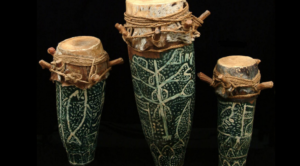 It might be clear now that the judeo-christian bigotry did not bring the Concept of Divine Trinity and the expression YEƲE to African People who are the Discoverers and Originators of these Concepts and Notions since the beginning of the History of Mankind. African People and Societies always rely all their spiritual, religious and social activities to the fundamental Concept of the Divine and complex Trinity, that they illustrate even through the performance of secular and sacred Music (see the African traditional Triadic Drumset for Ritual Music).
Another misconspection usually spreaded fallaciously over centuries is that the judeo-christian bigotry might have brought the notion of “Monotheism” to African People. It is also alledged fallaciously very often that African People are the sole polytheist people without any idea of “Monotheism” before the violent islamisation and christianisation and that these two violent religions have the mission to convert all African People to “Monotheism”.
It might be clear now that the judeo-christian bigotry did not bring the Concept of Divine Trinity and the expression YEƲE to African People who are the Discoverers and Originators of these Concepts and Notions since the beginning of the History of Mankind. African People and Societies always rely all their spiritual, religious and social activities to the fundamental Concept of the Divine and complex Trinity, that they illustrate even through the performance of secular and sacred Music (see the African traditional Triadic Drumset for Ritual Music).
Another misconspection usually spreaded fallaciously over centuries is that the judeo-christian bigotry might have brought the notion of “Monotheism” to African People. It is also alledged fallaciously very often that African People are the sole polytheist people without any idea of “Monotheism” before the violent islamisation and christianisation and that these two violent religions have the mission to convert all African People to “Monotheism”.
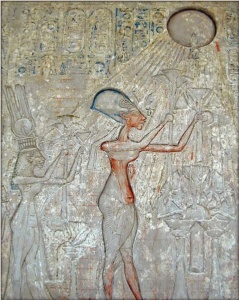 This fallacious and deliberately wrong allegation is first of all denied by the fact that Monotheism did not begin with the so-called abrahamic religions (judaism, christianism and islam), but rather in Africa during the reign of the Egyptian Farao Akhenaton (from 1351 to 1336 B.C.E.) who tried to put the Cult of Aton above all other religious cults. The attempt of the Farao Akhenaton must be understood in the real geopolitical and historical context of that time, because the neighbouring Empire of the Hittites (or Hethites) was trying to overthrow the Egyptian hegemony by introducing fallaciously through massive immigration different foreign religious beliefs and practices in the country and in the provinces under Egyptian control or under Egyptian influence (see below the geographical and historical Map of the Region at that time, from the German Egyptologist Jürgen Beckerath)
This fallacious and deliberately wrong allegation is first of all denied by the fact that Monotheism did not begin with the so-called abrahamic religions (judaism, christianism and islam), but rather in Africa during the reign of the Egyptian Farao Akhenaton (from 1351 to 1336 B.C.E.) who tried to put the Cult of Aton above all other religious cults. The attempt of the Farao Akhenaton must be understood in the real geopolitical and historical context of that time, because the neighbouring Empire of the Hittites (or Hethites) was trying to overthrow the Egyptian hegemony by introducing fallaciously through massive immigration different foreign religious beliefs and practices in the country and in the provinces under Egyptian control or under Egyptian influence (see below the geographical and historical Map of the Region at that time, from the German Egyptologist Jürgen Beckerath) 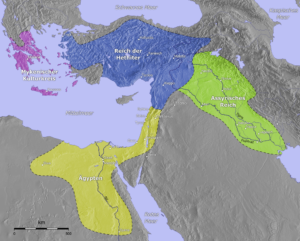 .
The serious scientific investigations and publications of the German Egyptologist Jan Assmann have proven that the biblical description about Moses is just a fake reproduction of the History about the monotheistic cult that the Farao Akhenaton has imposed by force around the Egyptian Sun-Deity Aton, in order to stop the spreading of the foreign religious practices coming from the Hittites.
The fallacious allegation from the so-called abrahamic religions (judaism, christianism, islam) trying always to deny any idea of Monotheism to African People is fundamentally wrong on the other hand, because the African Ancestral Cosmogony and Theogony state that the whole Divine Creation is the Work of an Almighty and very Complex Supreme Beeing (Mawugã in Eʋègbè) that must be understood as a complex Set of Holy and fundamental Laws and Principles (Ségbó in Eʋègbè) that no Human Beeing acting as an individual Image of this Divine Creator can never access alone in Its Totality and in it Its Complexity.
The fondamental Duty of every Human Beeing is to discover his own Personality as an Image of the Supreme and Divine Creator, to discover the Reason why he/she is on Earth, to discover the Mission he/she has to fullfil in his/her Life on Earth as the expression of his/her Destiny (Kpɔlí in Eʋègbè), in order to be in Harmony with one’s self and in Harmony with the whole Divine Creation through its complex Holy Laws and Principles (Sé in Eʋègbè).
It is clear therefore that spiritual and religious Thoughts among African People and their Descendents all over the world has nothing to do with a silly and foolish belief, teaching that one may go to God in heaven after the death in the name of a messia.
It has nothing to do with fanatic religious bigotries, with a silly religious proselytism or with blind religious violences.
It has rather to do with solid Faith gained by everyone through the access to a solid Knwoledge about the Divine Laws and Principles (Sé in Eʋègbè) governing Life and the whole Divine Creation. It is clear therefore why Spirituality and Religion in the African context always follow initiatic and systematic Processes foccussed on the Personnality and the Destinity of everyone.
References:
.
The serious scientific investigations and publications of the German Egyptologist Jan Assmann have proven that the biblical description about Moses is just a fake reproduction of the History about the monotheistic cult that the Farao Akhenaton has imposed by force around the Egyptian Sun-Deity Aton, in order to stop the spreading of the foreign religious practices coming from the Hittites.
The fallacious allegation from the so-called abrahamic religions (judaism, christianism, islam) trying always to deny any idea of Monotheism to African People is fundamentally wrong on the other hand, because the African Ancestral Cosmogony and Theogony state that the whole Divine Creation is the Work of an Almighty and very Complex Supreme Beeing (Mawugã in Eʋègbè) that must be understood as a complex Set of Holy and fundamental Laws and Principles (Ségbó in Eʋègbè) that no Human Beeing acting as an individual Image of this Divine Creator can never access alone in Its Totality and in it Its Complexity.
The fondamental Duty of every Human Beeing is to discover his own Personality as an Image of the Supreme and Divine Creator, to discover the Reason why he/she is on Earth, to discover the Mission he/she has to fullfil in his/her Life on Earth as the expression of his/her Destiny (Kpɔlí in Eʋègbè), in order to be in Harmony with one’s self and in Harmony with the whole Divine Creation through its complex Holy Laws and Principles (Sé in Eʋègbè).
It is clear therefore that spiritual and religious Thoughts among African People and their Descendents all over the world has nothing to do with a silly and foolish belief, teaching that one may go to God in heaven after the death in the name of a messia.
It has nothing to do with fanatic religious bigotries, with a silly religious proselytism or with blind religious violences.
It has rather to do with solid Faith gained by everyone through the access to a solid Knwoledge about the Divine Laws and Principles (Sé in Eʋègbè) governing Life and the whole Divine Creation. It is clear therefore why Spirituality and Religion in the African context always follow initiatic and systematic Processes foccussed on the Personnality and the Destinity of everyone.
References:
Many people often believe wrongly that the word YEƲE as well as many other words and their metaphysical meaning among the West African People living in the Gulf of Guinea might have beeing borrowed from the jewish or hebraic traditions through the violent and brutal christianization since the 18th century C.E. (common era).
 Some other people even believe not only wrongly, but also by ignorance coupled with a stinking arrogance, that African People did not have any clean idea of God before the violent islamization and christianization. They also allegate fallaciously very often that African Societies and Cultures before this violent islamization and christianization did not have any clean Teaching and Practice that enable people to communicate constantly with the Almighty.
But all these ideological lies cannot hide the undeniable historical Fact testifying that the ancestors of the Hebrews known as Hyksos were not worshiping any tribal God or tribal Deity called Yavhe (or Yahwe) when they were arriving as begging immigrants in Egypt around 1550 B.C.E (before common era!) during the reign of the Faraos Nehesi and Meredjefare. As semitic immigrants the ancestors of the Hebrews were worshiping a typical semitic deity known as Ba’al (or Baal), as it is attested by many serious historical and theological Studies (Kinet 1977, Kohlmeyer 1982, Niehr 1998, Niehr 2003).
The word YEƲE as well as all the other metaphysical words mentionned above and many others in the field of the hebraic Kabbala and in the jewish religious practices came from the mystical and religious circles of the multi-ethnic pharaonic Egypt and have been adopted through linguistic borrowing by all these immigrants that came into contact with the multi-ethnic and multi-lingual egyptian society.
This word always in use in the Egyptian mystical and spiritual circles long time before the massive immigration of many neighbouring aliens refer to the cosmogonical and spiritual Complexity of the Divine Creation that is structured permanently, not as a simple Trinity as the Judeo-Christian Plagiarism claim it wrongly and fallaciously, but rather in the form of a Triple Trinity.
Some other people even believe not only wrongly, but also by ignorance coupled with a stinking arrogance, that African People did not have any clean idea of God before the violent islamization and christianization. They also allegate fallaciously very often that African Societies and Cultures before this violent islamization and christianization did not have any clean Teaching and Practice that enable people to communicate constantly with the Almighty.
But all these ideological lies cannot hide the undeniable historical Fact testifying that the ancestors of the Hebrews known as Hyksos were not worshiping any tribal God or tribal Deity called Yavhe (or Yahwe) when they were arriving as begging immigrants in Egypt around 1550 B.C.E (before common era!) during the reign of the Faraos Nehesi and Meredjefare. As semitic immigrants the ancestors of the Hebrews were worshiping a typical semitic deity known as Ba’al (or Baal), as it is attested by many serious historical and theological Studies (Kinet 1977, Kohlmeyer 1982, Niehr 1998, Niehr 2003).
The word YEƲE as well as all the other metaphysical words mentionned above and many others in the field of the hebraic Kabbala and in the jewish religious practices came from the mystical and religious circles of the multi-ethnic pharaonic Egypt and have been adopted through linguistic borrowing by all these immigrants that came into contact with the multi-ethnic and multi-lingual egyptian society.
This word always in use in the Egyptian mystical and spiritual circles long time before the massive immigration of many neighbouring aliens refer to the cosmogonical and spiritual Complexity of the Divine Creation that is structured permanently, not as a simple Trinity as the Judeo-Christian Plagiarism claim it wrongly and fallaciously, but rather in the form of a Triple Trinity.
 The word was used in these very close Egyptian circles such as the polyvalent Training Institutions known as House of Life (Per Ankh, see Photo), to refer to any concrete or covert energetic Principle that exists as part of an active Triad, that always acts in a triadic Interaction and that can be understood therefore as the concrete and permanent triadic Equilibrum in the whole Divine Creation, as the concrete Footprint of God the Almighty.
It was used loosely therefore to talk about any Deity, that is considered in the Egyptian worldview as part of a permanent and recurrent complex Triad.
The semitic immigrants started to adopt Egyptian habits and customs such as the circumcision and they also started borrowing many words from the different fields of activities in KMT (Egypt).
They started therefore to name their tribal Deity Ba’al with the same word YEƲE, like the Egyptians who used to name any important Triadic Deity in their Pantheon with this expression (cf. Kinet 1977 and Niehr 2003).
And the Hebrews have borrowed many other words from the Egyptian spiritual and mystical fields of activities, even though the phonetic pronounciation and the meaning of these borrowed words have been corrupted in the target language (the Hebrew), as it often happens in the case of any linguistic and cultural borrowing.
It is clear therefore why the hebraic/jewish mystical Tradition (known as the Kabbala) is full of many borrowed words from African Languages which are still in use in West African mystical and religious circles (e.g. the Gbè linguistic Cluster including Eʋègbè, Fɔngbe, Ajagbe, Wacigbe, Gɛngbe, Gungbe, χwlagbe, cf. Folikpo, 2006).
The Hebrew communities that have left later the Nile Delta to settle down in the Mountains of Sinaï during the reign of the Faraos Kamose and Ahmose I (around 1500 B.C.E.) did not only continue to call their tribal Deity with the corrupted epithet Yavhe that is derived from the word YEƲE, but they also kept the other expressions and notions they have wrongly borrowed from the Egyptian society.
The second group of Hebrew communities that had left Egpyt during the reign of the Farao Ramses II brought these religious practices in the region of Canaan and Midian (cf. Folikpo 2017).
It is obvious therefore that the semitic tribal Deity known as Ba’al has undergone a religious and cultural metamorphosis through the contact with Egypt where it has received a new epithet (Yavhe) and new practices for worshiping (cf. Folikpo 2017).
Since the Hebrews did not discover by their own or invent by their own the concept of Divine Triad and the expression YEƲE, but have copied them (wrongly) from the Egyptian Culture and Civilization, it is obvious why they could never give any clear cosmonogical explanation for them and have always covered them with a certain speculative “mystery”.
The word was used in these very close Egyptian circles such as the polyvalent Training Institutions known as House of Life (Per Ankh, see Photo), to refer to any concrete or covert energetic Principle that exists as part of an active Triad, that always acts in a triadic Interaction and that can be understood therefore as the concrete and permanent triadic Equilibrum in the whole Divine Creation, as the concrete Footprint of God the Almighty.
It was used loosely therefore to talk about any Deity, that is considered in the Egyptian worldview as part of a permanent and recurrent complex Triad.
The semitic immigrants started to adopt Egyptian habits and customs such as the circumcision and they also started borrowing many words from the different fields of activities in KMT (Egypt).
They started therefore to name their tribal Deity Ba’al with the same word YEƲE, like the Egyptians who used to name any important Triadic Deity in their Pantheon with this expression (cf. Kinet 1977 and Niehr 2003).
And the Hebrews have borrowed many other words from the Egyptian spiritual and mystical fields of activities, even though the phonetic pronounciation and the meaning of these borrowed words have been corrupted in the target language (the Hebrew), as it often happens in the case of any linguistic and cultural borrowing.
It is clear therefore why the hebraic/jewish mystical Tradition (known as the Kabbala) is full of many borrowed words from African Languages which are still in use in West African mystical and religious circles (e.g. the Gbè linguistic Cluster including Eʋègbè, Fɔngbe, Ajagbe, Wacigbe, Gɛngbe, Gungbe, χwlagbe, cf. Folikpo, 2006).
The Hebrew communities that have left later the Nile Delta to settle down in the Mountains of Sinaï during the reign of the Faraos Kamose and Ahmose I (around 1500 B.C.E.) did not only continue to call their tribal Deity with the corrupted epithet Yavhe that is derived from the word YEƲE, but they also kept the other expressions and notions they have wrongly borrowed from the Egyptian society.
The second group of Hebrew communities that had left Egpyt during the reign of the Farao Ramses II brought these religious practices in the region of Canaan and Midian (cf. Folikpo 2017).
It is obvious therefore that the semitic tribal Deity known as Ba’al has undergone a religious and cultural metamorphosis through the contact with Egypt where it has received a new epithet (Yavhe) and new practices for worshiping (cf. Folikpo 2017).
Since the Hebrews did not discover by their own or invent by their own the concept of Divine Triad and the expression YEƲE, but have copied them (wrongly) from the Egyptian Culture and Civilization, it is obvious why they could never give any clear cosmonogical explanation for them and have always covered them with a certain speculative “mystery”.
 It might be clear now that the judeo-christian bigotry did not bring the Concept of Divine Trinity and the expression YEƲE to African People who are the Discoverers and Originators of these Concepts and Notions since the beginning of the History of Mankind. African People and Societies always rely all their spiritual, religious and social activities to the fundamental Concept of the Divine and complex Trinity, that they illustrate even through the performance of secular and sacred Music (see the African traditional Triadic Drumset for Ritual Music).
Another misconspection usually spreaded fallaciously over centuries is that the judeo-christian bigotry might have brought the notion of “Monotheism” to African People. It is also alledged fallaciously very often that African People are the sole polytheist people without any idea of “Monotheism” before the violent islamisation and christianisation and that these two violent religions have the mission to convert all African People to “Monotheism”.
It might be clear now that the judeo-christian bigotry did not bring the Concept of Divine Trinity and the expression YEƲE to African People who are the Discoverers and Originators of these Concepts and Notions since the beginning of the History of Mankind. African People and Societies always rely all their spiritual, religious and social activities to the fundamental Concept of the Divine and complex Trinity, that they illustrate even through the performance of secular and sacred Music (see the African traditional Triadic Drumset for Ritual Music).
Another misconspection usually spreaded fallaciously over centuries is that the judeo-christian bigotry might have brought the notion of “Monotheism” to African People. It is also alledged fallaciously very often that African People are the sole polytheist people without any idea of “Monotheism” before the violent islamisation and christianisation and that these two violent religions have the mission to convert all African People to “Monotheism”.
 This fallacious and deliberately wrong allegation is first of all denied by the fact that Monotheism did not begin with the so-called abrahamic religions (judaism, christianism and islam), but rather in Africa during the reign of the Egyptian Farao Akhenaton (from 1351 to 1336 B.C.E.) who tried to put the Cult of Aton above all other religious cults. The attempt of the Farao Akhenaton must be understood in the real geopolitical and historical context of that time, because the neighbouring Empire of the Hittites (or Hethites) was trying to overthrow the Egyptian hegemony by introducing fallaciously through massive immigration different foreign religious beliefs and practices in the country and in the provinces under Egyptian control or under Egyptian influence (see below the geographical and historical Map of the Region at that time, from the German Egyptologist Jürgen Beckerath)
This fallacious and deliberately wrong allegation is first of all denied by the fact that Monotheism did not begin with the so-called abrahamic religions (judaism, christianism and islam), but rather in Africa during the reign of the Egyptian Farao Akhenaton (from 1351 to 1336 B.C.E.) who tried to put the Cult of Aton above all other religious cults. The attempt of the Farao Akhenaton must be understood in the real geopolitical and historical context of that time, because the neighbouring Empire of the Hittites (or Hethites) was trying to overthrow the Egyptian hegemony by introducing fallaciously through massive immigration different foreign religious beliefs and practices in the country and in the provinces under Egyptian control or under Egyptian influence (see below the geographical and historical Map of the Region at that time, from the German Egyptologist Jürgen Beckerath)  .
The serious scientific investigations and publications of the German Egyptologist Jan Assmann have proven that the biblical description about Moses is just a fake reproduction of the History about the monotheistic cult that the Farao Akhenaton has imposed by force around the Egyptian Sun-Deity Aton, in order to stop the spreading of the foreign religious practices coming from the Hittites.
The fallacious allegation from the so-called abrahamic religions (judaism, christianism, islam) trying always to deny any idea of Monotheism to African People is fundamentally wrong on the other hand, because the African Ancestral Cosmogony and Theogony state that the whole Divine Creation is the Work of an Almighty and very Complex Supreme Beeing (Mawugã in Eʋègbè) that must be understood as a complex Set of Holy and fundamental Laws and Principles (Ségbó in Eʋègbè) that no Human Beeing acting as an individual Image of this Divine Creator can never access alone in Its Totality and in it Its Complexity.
The fondamental Duty of every Human Beeing is to discover his own Personality as an Image of the Supreme and Divine Creator, to discover the Reason why he/she is on Earth, to discover the Mission he/she has to fullfil in his/her Life on Earth as the expression of his/her Destiny (Kpɔlí in Eʋègbè), in order to be in Harmony with one’s self and in Harmony with the whole Divine Creation through its complex Holy Laws and Principles (Sé in Eʋègbè).
It is clear therefore that spiritual and religious Thoughts among African People and their Descendents all over the world has nothing to do with a silly and foolish belief, teaching that one may go to God in heaven after the death in the name of a messia.
It has nothing to do with fanatic religious bigotries, with a silly religious proselytism or with blind religious violences.
It has rather to do with solid Faith gained by everyone through the access to a solid Knwoledge about the Divine Laws and Principles (Sé in Eʋègbè) governing Life and the whole Divine Creation. It is clear therefore why Spirituality and Religion in the African context always follow initiatic and systematic Processes foccussed on the Personnality and the Destinity of everyone.
References:
.
The serious scientific investigations and publications of the German Egyptologist Jan Assmann have proven that the biblical description about Moses is just a fake reproduction of the History about the monotheistic cult that the Farao Akhenaton has imposed by force around the Egyptian Sun-Deity Aton, in order to stop the spreading of the foreign religious practices coming from the Hittites.
The fallacious allegation from the so-called abrahamic religions (judaism, christianism, islam) trying always to deny any idea of Monotheism to African People is fundamentally wrong on the other hand, because the African Ancestral Cosmogony and Theogony state that the whole Divine Creation is the Work of an Almighty and very Complex Supreme Beeing (Mawugã in Eʋègbè) that must be understood as a complex Set of Holy and fundamental Laws and Principles (Ségbó in Eʋègbè) that no Human Beeing acting as an individual Image of this Divine Creator can never access alone in Its Totality and in it Its Complexity.
The fondamental Duty of every Human Beeing is to discover his own Personality as an Image of the Supreme and Divine Creator, to discover the Reason why he/she is on Earth, to discover the Mission he/she has to fullfil in his/her Life on Earth as the expression of his/her Destiny (Kpɔlí in Eʋègbè), in order to be in Harmony with one’s self and in Harmony with the whole Divine Creation through its complex Holy Laws and Principles (Sé in Eʋègbè).
It is clear therefore that spiritual and religious Thoughts among African People and their Descendents all over the world has nothing to do with a silly and foolish belief, teaching that one may go to God in heaven after the death in the name of a messia.
It has nothing to do with fanatic religious bigotries, with a silly religious proselytism or with blind religious violences.
It has rather to do with solid Faith gained by everyone through the access to a solid Knwoledge about the Divine Laws and Principles (Sé in Eʋègbè) governing Life and the whole Divine Creation. It is clear therefore why Spirituality and Religion in the African context always follow initiatic and systematic Processes foccussed on the Personnality and the Destinity of everyone.
References:
- ASSMANN, Jan: Moses der Ägypter: Entzifferung einer Gedächtnisspur. München: Hanser, 1992.
- ASSMANN, Jan: Le prix du monothéisme. Paris: Payot, 2007.
- ASSMANN, Jan: Le monothéisme et le langage de la violence. Les débuts bibliques de la religion radicale. Paris: Bayard Jeunesse, 2018
- BECKERATH (von), Jürgen: Chronologie des pharaonischen Ägypten. Die Zeitbestimmung der ägyptischen Geschichte von der Vorzeit bis 332 v. Chr. (in the Series: Münchner ägyptologische Studien. Bd. 46). Mainz: von Zabern, 1997.
- FOLIKPO, Kofi K.: Emprunt linguistique et Univers ontologique trans-culturel: Le cas de l’apport du Gbè au Hébreux classique et à la Kabbale hébraïque. 2006, (published for download on https://independent.academia.edu/KofiFolikpo )
- FOLIKPO, Kofi K.: Du Mythe sur le “Peuple élu de Dieu” au Mythe sur la “Tribu perdue d’Israël” en Afrique: Contribution à la Renaissance de la Conscience collective Kamite. 2017 (Published for download on https://independent.academia.edu/KofiFolikpo ).
- GERHARDS, Meik: Die biblischen Hethiter. In: Die Welt des Orients. Band 39, 2009, pages 145 – 179.
- HAAS, Volkert: Geschichte der hethitischen Religion. Handbuch der Orientalistik. Abteilung 1, Band 15. Leiden: Brill Publishers, 1994.
- KINET, Dirk: Ba’al und Jahwe: Ein Beitrag zur Theologie des Hoseabuches (German Edition). Frankfurt/Main: Peter Lang 1977 (in the series Europäische Hochschulschriften / European University Studies / Publications Universitaires Européennes).
- KOHLMEYER, Kay: Land des Baal. Syrien. Forum der Völker und Kulturen. Mainz/Rhein: Philipp von Zabern, 1982.
- NIEHR, Herbert: Religionen in Israels Umwelt.(Die neue Echter-Bibel/Ergänzungsband 5). Würzburg: Echter, 1998.
- NIEHR, Herbert: Ba’alsamem. Studien zur Hekunft, Geschichte und Rezeptionsgeschichte eines phönizischen Gottes. Leuven: Peeters, 2003.



